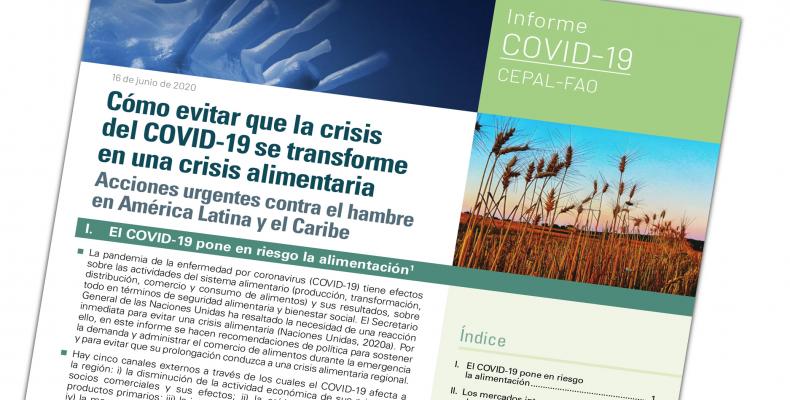As a result of the crisis prompted by the COVID-19 pandemic, the population living in extreme poverty in Latin America and the Caribbean could reach 83.4 million people in 2020, which would entail a significant rise in hunger levels due to the difficulties these people will face in accessing food, the Economic Commission for Latin America and the Caribbean (ECLAC) and the Food and Agriculture Organization of the United Nations (FAO) has indicated.
These organizations presented a joint report entitled Preventing the COVID-19 crisis from becoming a food crisis: Urgent measures against hunger in Latin America and the Caribbean, in which they propose urgent steps to tackle the increased hunger resulting from the pandemic in the region’s countries.
According to the report, after seven years of slow growth, Latin America and the Caribbean could experience the biggest drop in regional GDP in a century (-5.3%), which will push 16 million more people into conditions of extreme poverty in 2020 versus the previous year, to total 83.4 million people in all. The impact on hunger will also be very significant, taking into account that in 2016-2018 there were already 53.7 million people experiencing severe food insecurity in Latin America.
The effects of the crisis can already be seen in food systems: workers’ vulnerability has grown and domestic food prices are rising more than the price of other products in the basic basket, according to the Consumer Price Index (CPI). Due to increased unemployment and declining income, millions of people are not able to buy enough food, and many others are being forced to opt for cheaper food that has less nutritional value.
Anti-hunger grant for the vulnerable population and credit for producers
“The major task we have ahead of us is to keep the health crisis from turning into a food crisis. That is why we are proposing complementing the Emergency Basic Income (EBI) with the provision of an Anti-Hunger Grant (AHG),” stated Alicia Bárcena, ECLAC’s Executive Secretary.
“In Latin America, we may have a historic setback in the fight against hunger. In a matter of months, we may lose what we have achieved in fifteen years. Millions of people may end up going hungry. That is the gravity of the current problem,” FAO’s Regional Representative, Julio Berdegué, explained.
According to the report, the Anti-Hunger Grant could take the form of cash transfers, food baskets or vouchers to the entire population living in extreme poverty for a six-month period, equivalent to 70% of the regional extreme poverty line ($47 dollars based on the 2010 dollar). Its cost would amount to 0.06% of regional GDP if it were provided exclusively to the population aged 65 and older that lives in extreme poverty, or to 0.45% of GDP if coverage were given to the entire population facing extreme poverty. ECLAC and FAO recommend the latter option, which would have an estimated cost of $23.5 billion dollars.
For producers in the food system, they propose an increase of at least 20% in the average credit portfolio from the last three years, which would add up to around $5.5 billion dollars, for loans under favorable conditions that would be financed by a special line from multilateral and development banks. In addition, for the family farm units that lag the furthest behind, a basic investment kit ($250 dollars) could be provided on a regional scale at a cost of $1.7 billion dollars. The joint report calls for international cooperation to support countries in greater situations of vulnerability.
Ten measures to prevent a food crisis
The agencies propose the anti-hunger grant as part of a set of measures aimed at ensuring that all households can access sufficient, nutritious food; food system companies and stakeholders can carry out their work; and countries can have enough food to guarantee supply at reasonable prices.
The other measures forming part of this ten-point list are:
- Reinforce school-based food programs to ensure that children and adolescents get fed.
- Support civil society organizations’ food assistance initiatives.
- Financial support (credit and production subsidies) for agricultural companies, oriented mainly towards family agriculture.
- Adjust sanitary and health protocols for food production and transportation and in wholesale and retail markets.
- Expand and ensure the functioning of programs to support production for one’s own consumption.
- Ensure funding, technical assistance, and access to inputs and labor for artisanal farmers and fishermen and women.
- Establish streamlined mechanisms for consultation and public-private coordination among all the stakeholders in the food system.
- Prevent wholesale and retail markets and agro-industries from closing or reducing their operations.
- Maintain the policies that have kept global food trade open, in particular avoiding protectionist measures that would increase food prices.
source: eclac


